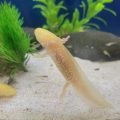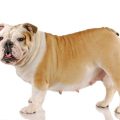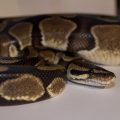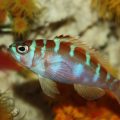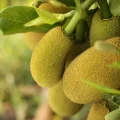Are you looking to add some vibrant color to your aquarium? Look no further than the Ember Tetra! These small schooling fish are a great addition for any home aquarist looking for an easy-care, beautiful fish.
Ember Tetras (Hyphessobrycon amandae) are native to South America and live in the fast-flowing rivers of the Amazon basin. They come in a range of bright colors such as orange, red and yellow, making them an eye-catching addition to any tank. These small tetras grow up to 2 cm (0.8 in) in length, making them a great choice for nano tanks or smaller aquariums.
Ember Tetras are relatively hardy fish and will adapt well to most water conditions as long as they’re kept stable. They prefer soft acidic water with temperatures between 73-82°F (23-28°C). As these fish live in large groups in the wild, it is important to keep at least 10-15 of them together when setting up a tank for Ember Tetras. This will ensure that they feel comfortable and enriched by their buddies. For 8 Ember Tetras, we recommend a 10 gallon tank so that each one has enough space to feel comfortable – around 1 – 1.2 gallons per fish.
When it comes to food, Ember Tetras are not picky eaters! They will happily feed on flakes or pellets, freeze dried food and even frozen food like brine shrimp or daphnia. It is important to feed them small amounts seveal times a day rather than one large meal as this ensures that all the fish get their fair share of food and prevents overfeeding which can lead to health complications down the line.
Overall, Ember Tetras are an excellent choice for beginner aquarists who want an easy care colorful addition to their home aquariums! With their peaceful nature and vibrant colors they’re sure to bring life and energy into your tank!
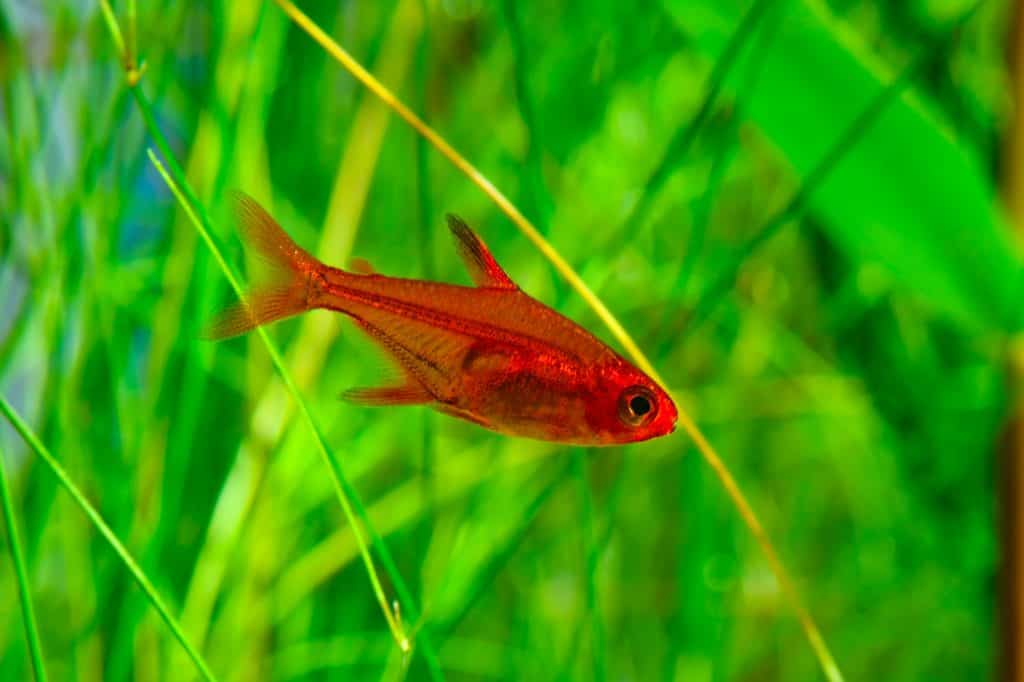
Ideal Group Size for Ember Tetras
Ideally, you should keep at least 10-15 Ember Tetras together in an aquarium. This is important for the fish’s socialization and enrichment as they are schooling fish and prefer to be in groups. Keeping them in smaller groups can lead to aggression and territorial behavior, so it’s best to keep a larger school of at least 10-15 individuals.
The Difficulty of Keeping Ember Tetras
Ember Tetras are generally a hardy species and can survive most conditions. However, it is important to keep in mind that they are quite sensitive to parameter fluctuations. Therefore, if you want your Ember Tetras to thrive, it is best to wait until your tank is fully cycled before introducing them. With proper care and attention, you should be able to keep Ember Tetras successfully.
Maximum Size of Ember Tetras
Ember Tetras can reach a maximum overall length of approximately 2 cm (0.8 in). They are considered a small fish species, with an average adult size of around 1.5 cm (0.6 in). Their bodies are typically of a tetra shape, and they exhibit striking orange and reddish coloration with mild translucency near the pelvic fin. The eye is often outlined in black and mirrors the color of the fish.
Recommended Number of Ember Tetras for a 10 Gallon Tank
For a healthy and comfortable environment, it is best to keep 8 Ember Tetras in a 10 gallon tank. Each Ember Tetra needs roughly 1 to 1.2 gallons of space, so 10 gallons is the ideal size for a school of 8 Ember Tetras. It is important to remember that overcrowding the tank can lead to increased stress levels and could even cause illness in your fish. Therefore, it is important to maintain proper stocking levels in your tank in order to ensure the health and well-being of your fish.
Creating the Ideal Tank Environment for Ember Tetras
Ember Tetras are freshwater fish that prefer an aquarium environment with a pH range of 5.5-7, water hardness of 18dH or less, and a temperature of 68-82°F. They also like slow-flowing water, so it’s important to make sure the filtration system is not too powerful. Additionally, they should be kept in a well-planted tank with plenty of hiding spots; they also enjoy swimming around areas with driftwood and rocks. Lastly, try to keep their tank as dark as possible; dim lighting can reduce stress and help them feel more secure.
Are Ember Tetras Fin Nippers?
Ember Tetras are generally peaceful fish that are not prone to fin nipping. While it is possible for them to nip at other fish’s fins, this behavior is usually a result of overcrowding or stress. To prevent fin nipping from occurring, it is recommended to keep Ember Tetras in a school of at least six individuals, and to provide them with a peaceful environment with plenty of hiding places. Additionally, ensuring the tank is well-maintained and that all other fish in the tank are compatible with Ember Tetras will help minimize any unnecessary stress or aggression.
Is a School of Six Ember Tetras Sufficient?
Six Ember tetras is enough for a 10-gallon tank, as the minimum amount of Ember tetras you should have together is two. This means that six would be a good number to keep them socially active, and they will likely not get as lonely. However, it is important to note that if you want them to school, then you should aim for a larger tank size and more than six fish. Overall, six Ember tetras should be enough for a 10-gallon tank.
Compatible Tankmates for Ember Tetras
Ember Tetras are peaceful fish that make a great addition to any aquarium. They can live comfortably alongside other tetras, such as Glowlight and Neon Tetras, as well as a variety of other fish species. Pygmy Rasbora, Pleco Catfish, Cichlids, and Arowanas are some of the best tank mates for Ember Tetras.
Pygmy Rasbora are small fish that stay near the top of the tank. They will swim in schools with Ember Tetra and their bright colors will add to the beauty of the tank.
Pleco Catfish are peaceful bottom dwellers that can help keep algae under control. They should only be added to larger tanks so they can find enough food and have plenty of hiding places.
Cichlids are robust fish that come in a variety of sizes and colors. While some cichlids can be aggressive tward Ember Tetras, others like Angelfish or Discus can make good companions for them in a large tank with plenty of hiding spots to help prevent aggression from either species.
Finally, Arowanas are large predators that should not be kept with Ember Tetras due to their hunting instincts and size difference. However, if you have an appropriately sized tank (125 gallons or more) Arowanas may make an interesting addition to your aquarium community.
Can Ember Tetras and Bettas Coexist?
Yes, Ember Tetras are known to get along well with Betta fish in the same tank. Both species of fish prefer similar water conditions, such as a pH between 6.0-7.5 and a temperature of 72-82°F, and will be comfortable in similar tank setups. They also share similar diets, so it’s easy to provide both species with appropriate nutrition. Ember Tetras and Betta fish can peacefully coexist in the same aquarium, providing an active and colorful environment for all inhabitants.
Can Ember Tetras and Neon Tetras Coexist?
Yes, Ember Tetras and Neon Tetras can live together in the same aquarium. They have similar behavior and temperament, so they usually get along quite well. In order to povide the best environment for them, the tank should be 20 gallons or larger with plenty of hiding places and vegetation for them to explore. The water temperature should stay between 74-82°F and pH between 6.0-7.5; both are tropical fish so they do require a heater. To ensure their health, it is also important to keep the water clean by performing regular water changes. With the right conditions, these two species will school and swim together peacefully, making a beautiful addition to any aquarium!
Do Ember Tetras Exhibit Jumping Behavior?
No, Ember Tetras generally do not jump. They are a type of bottom-dwelling tetra and are more comfortable in the lower levels of an aquarium. When given ample space and plenty of hiding places, they rarely venture to the surface. If kept in an aquarium without a top, Ember Tetras should not be expected to jump out of the tank.
Does Ember Tetra Nipping Pose a Risk to Betta Fins?
Ember tetras have the potential to nip Betta fins, especially if they are kept in an overcrowded tank. To prevent this from happening, it is important to provide plenty of space for the Ember tetras to roam. A tank of at least 20 gallons is recommended for a school of 6 Ember tetras. In addition, provide plenty of hiding spots and other decorations in the tank so that all fish have their own territory and feel safe. If you observe any signs of fin nipping, separate the Betta into its own tank immediately.
Feeding Habits of Ember Tetras
Ember Tetras are omnivorous fish that require a varied diet. In the wild, they feed on small invertebrates and plant matter. In captivity, they should be offered a variety of foods such as high-quality flake or pellet food, frozen or freeze-dried bloodworms, tubifex worms, brine shrimp, daphnia, fruitflies and other insect larvae, as well as blanched vegetables like lettuce and spinach. Live foods such as microworms and grindal worms are also great for providing variety in their diet. It is important to provide your tetras with a balanced diet to ensure optimal health.
Conclusion
In conclusion, Ember Tetras are a hardy and beautiful species of small fish that make an ideal addition to any freshwater aquarium. They are best kept in groups of 10-15 and require a minimum tank size of 10 gallons. Although they are not difficult to care for, they are sensitive to parameter fluctuations, so it is important to keep the tank cycled before introducing them. With their bright orange and red coloration and mild translucency near the pelvic fin, Ember Tetras bring vibrant life to any aquarium.





